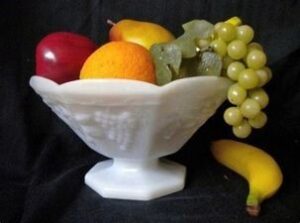Forbidden Fruit

I woke up this morning to find an Instagram post from my dear friend Matt Jardine, who shockingly displayed disdain for plastic fruit. How about a trigger warning? It’s a great short piece where he likens clichés to plastic fruit. I agree with his thoughts; however, picking on plastic fruit must be addressed. So here we are – a blogatini about faux fruit. Not in my plan for the day.
As a child of the 50’s – yes, I’m that old – growing up in an Italian family, plastic everything and gold spray paint were hallmarks of fine decorating. (Once we came home after school to find that my dad spray painted the inside of the fireplace with glitter gold paint.)
Not only did my mom adorn our tables with plasticized fruit, my brother and I endured the plastic made-to-order slipcovers on every piece of living room furniture. Try to peel your sweaty young legs off that couch in a hurry! And that happened when unexpected company would ring the bell. We dutifully scraped ourselves off the couch and swiftly unzipped and stashed the plastic to reveal the pristine threads, never touched by human hands, or at least not ours. And throughout each visit, we silently watched and prayed that our guests would properly balance their pepperoni and well-oiled, heavily seasoned, cracked green olives on their dishes. Kids, go into the kitchen to eat. Can you imagine a spill on the couch? Such tension.
But back to the plastic fruit that is emblazoned on my brain. You see, it was my job to dust those flawless gems. (My mom was a Virgo, and everything had to be just so). Should I mention that I also had to clean the plastic houseplants with Pledge? Are they shiny enough?
Such lovely fruit! The look-alike d’Anjou pear with its static brownish blemish. The ever-golden banana and its faux bruise. And the grapes! Ahh – the deep purple grapes that squished between my fingers. How many times did I squeeze those grapes hoping that one day perhaps they would be real? And the impeccably shaped green ones draped over the side of the milk glass bowl. Ah, such perfection.
Fast forward to today.
The world has become increasingly aware of environmental pollution’s dangers, pushing for more planet-friendly products. How about plastic fruit, which has several advantages over traditional fruits? Plastic fruit is a smart way to reduce the waste we produce while allowing us to enjoy the same delicious flavors in our minds—no more spoiled or mushy fruit in our garbage pails.
That’s right, think of the durability. Because they are made of plastic, they won’t rot, mold, or attract pests like traditional fruits often do. Bonus – no more fruit flies, either.
Another advantage of plastic fruit is that they are easier to clean than traditional fruits. Because they don’t have any skin or flesh, there’s no need to worry about peeling, cutting, or deseeding. Just a quick rinse now and then, or maybe a job for a child? Turn off your cell phone, Johnny. It’s time to clean the fruit.
Finally, plastic fruit is much more affordable than natural fruits. Buy them once, and you’re done. This means you can enjoy the same stunning visual without repeatedly spending a lot of money. A permanent centerpiece that lasts for generations. A legacy, if you will.
So now that I’ve cherry-picked just some of the virtues of plastic fruit, consider reviving this lost decoration art. Get yourself some faux fruit. Place the fruits on shelves, counters, window sills, or tables. Arrange them in baskets, and drape them in bowls or vases to make them look like they are naturally growing on the counter or shelf. You can also hang some fruits from the ceiling to create an interesting visual effect. Hang them high enough to avoid low-hanging fruit.
I hope you enjoyed the fruits of my labor. But, wait – is that another cliché? Or is it an idiom? (Love you, Matt – you know you’re the apple of my eye.)
And don’t get me started on silk flowers …
PR – Faux Fruit Fan Club President
